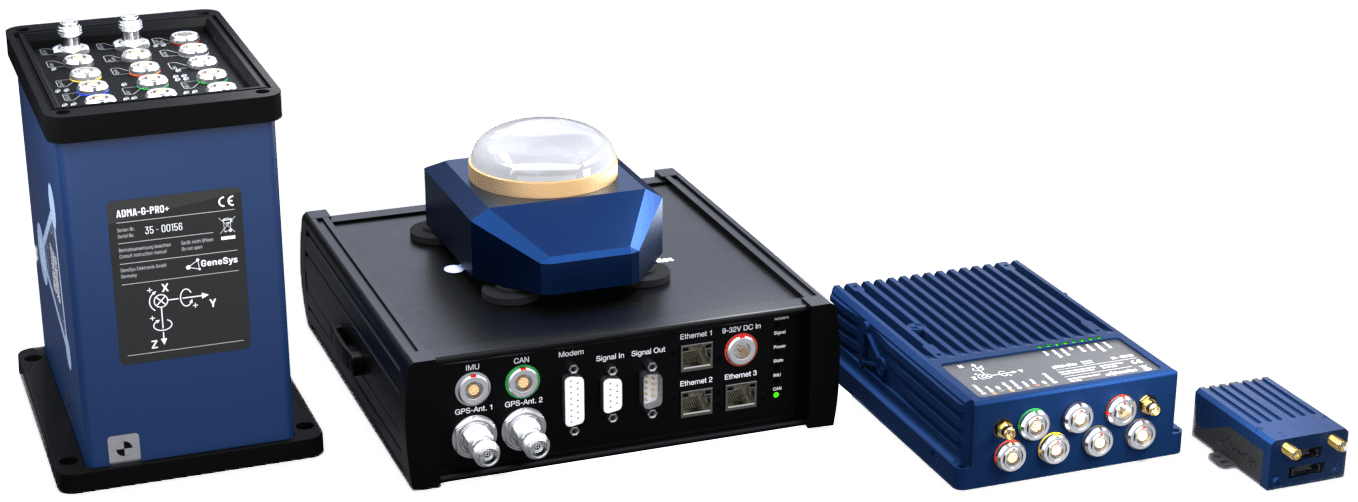Installation in the vehicle
The ideal point of installation for a gyro system inside a vehicle is at the theoretical center of motion. The x-axis of the system should be aligned to the driving direction of the vehicle. Otherwise the angle offset has to be compensated by the mounting offset configuration.
Warning: Take care not to crush the IMU cable with the vehicle window or door closure. The cable may break which leads to male functioning.
If the installation at the center of motion is not possible, the ADMA system needs to be positioned at a point inside the vehicle which is more accessible.
Note: Compensating the installation position describes how to compensate the installation position and alignment discrepancies of the ADMA. Safe and secure installation of the ADMA is essential to receive reliable data.

The GNSS antenna must be mounted on the roof of the vehicle. For best performance, it is necessary to mount the GNSS antenna(s) away from any object that may shadow the satellite signal. To reduce the influence of multipath, the antenna(s) should be mounted on a metal surface by using the magnetic mounts. We recommend to keep the system at least 30 cm away from glass surface or outer edges of the vehicle.
If the installation point on the roof of the vehicle can be freely selected, it is advisable to select a point directly above the ADMA. This is where the vector to the installation point of the ADMA is at its shortest and the effects of pitching and rolling are at a minimum.
Point of installation for ADMA-Speed
Mount the ADMA-Speed antenna in a suitable position on the roof of the vehicle. The ideal position is in the front or back of the roof, on a rigid area away from any objects that may shadow the GNSS signal such as roof bars. The data processing unit can be installed anywhere in the vehicle.
Warning: Take care not to crush the IMU cable with the vehicle window or door closure, the cable might break, and the system delivers no/wrong data. Safe and secure installation of the ADMA is essential to receive reliable data.

Do not mount the ADMA-Speed nearby or directly on a glass roof. We recommend to keep the system at least 30 cm away from glass surface or outer edges of the vehicle.

When using the ADMA-Speed, no offsets between GNSS Antenna and IMU have to be measured, because they are combined in one housing. The offset values can be found at this article.
ADMA-Slim
The ADMA-Slim can be installed in a suitable position anywhere in or on the roof of the vehicle.
The GNSS antenna must be mounted on the roof of the vehicle. For best performance, it is necessary to mount the GNSS antenna(s) away from any object that may shadow the satellite signal.
Install the ADMA-Slim on a rigid system. Ensure that a rotational or linear motion of the ADMA-Slim is avoided while the vehicle is moving.
The ADMA-Slim is usually installed with the x-axis arrow on the ADMA-Slim facing towards the driving direction. Other installation positions are possible if the relevant modifications to the ADMA Webinterface (6️⃣ PARAMETERS) are made.
Warning: Take care not to crush the IMU cable with the vehicle window or door closure, the cable might break, and the system delivers no/wrong data. Safe and secure installation of the ADMA-Slim is essential to receive reliable data.


For installing the unit at the roof magnetic foots can be fastened.

When installing the ADMA-Slim at the roof, the antenna can be mounted directly on the ADMA by using the fixture kit. For more detailed information please check the article ADMA-Slim fixture kit.



